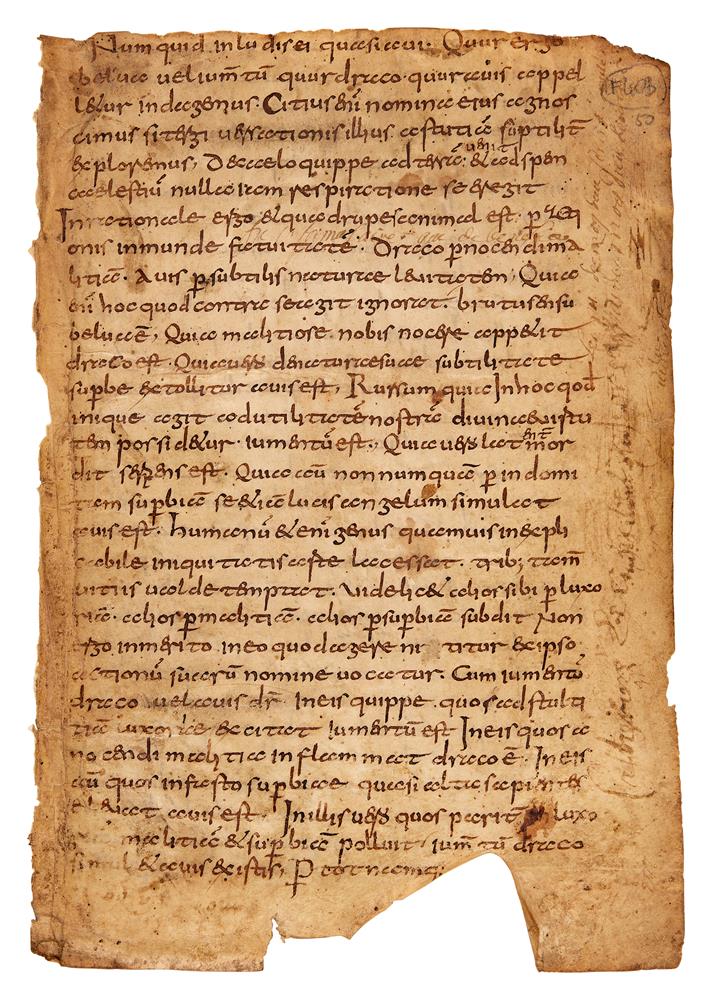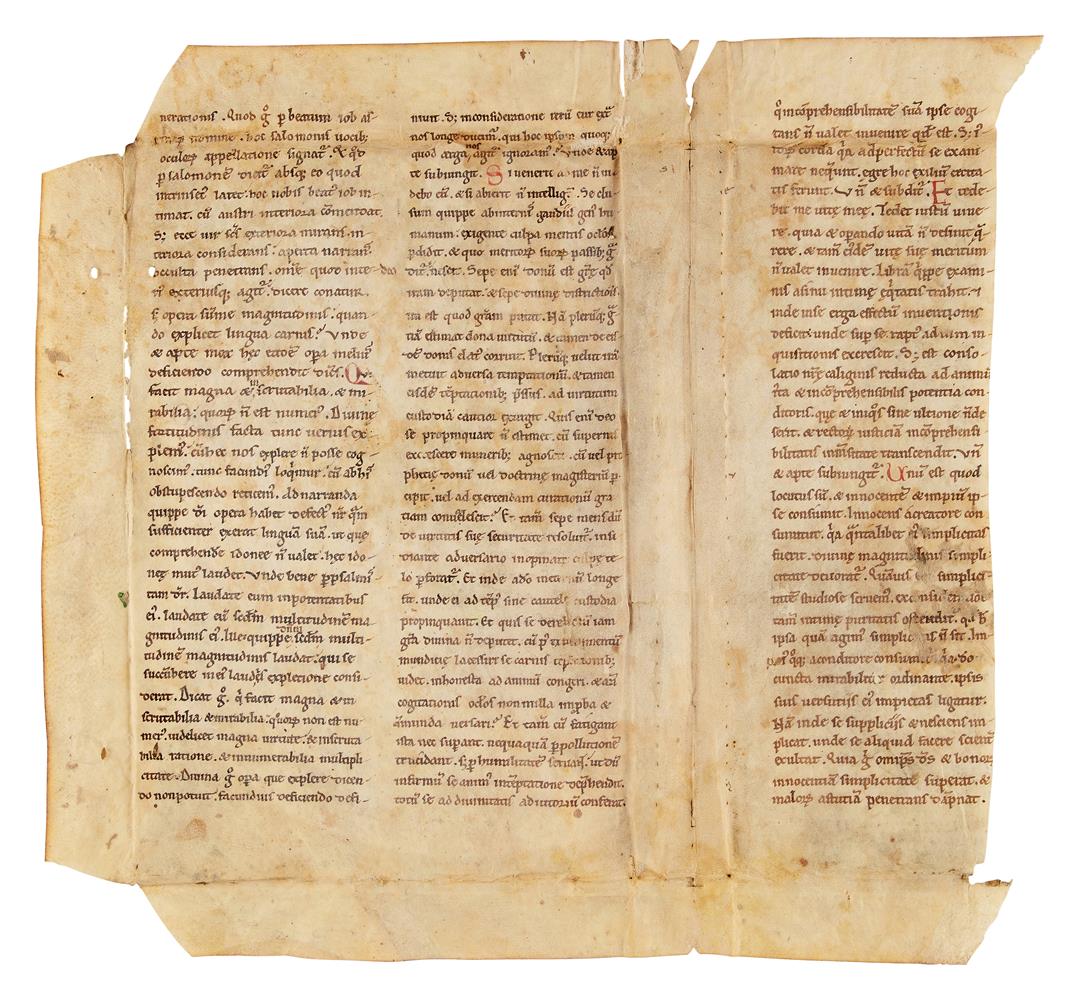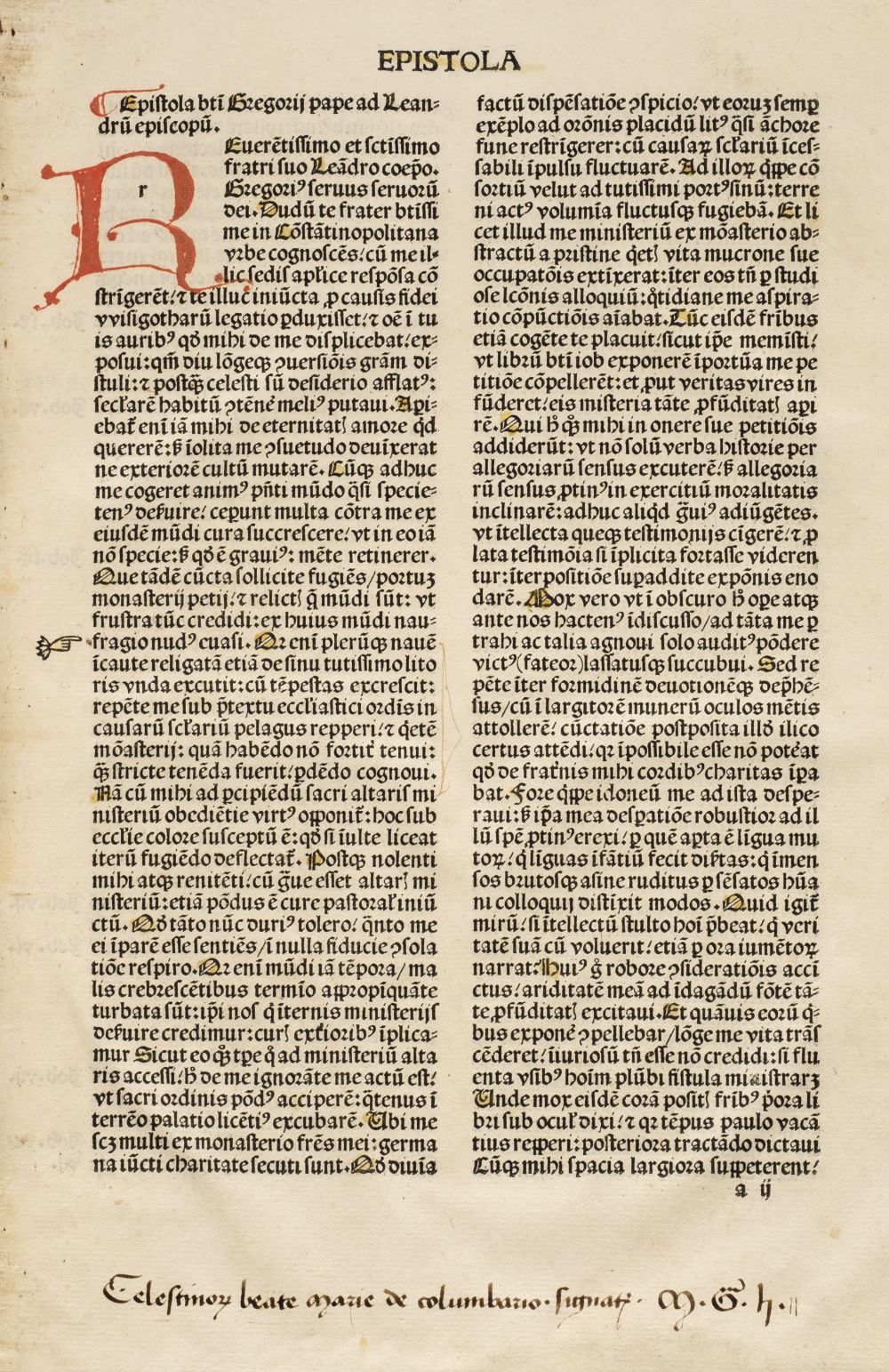Ɵ Gregory the Great, Moralia in Job, in Latin, large cutting from a manuscript on parchment, surviving in situ on the binding of a printed copy of Introductionis ad artem Rhetoricam, Libri II, ex Cicerone potissimum depropti et ad usum puerorum usum accommodati (Perugia: Vincentius Columbarius, 1596)[Southern Italy (most probably Apulia), first half or mid-eleventh century] Cutting from a leaf with double column of 29 lines in a rounded and proud Beneventan minuscule, initials in larger capitals in same pen, some holes and scuffs concomitant with reuse in binding (with some small affects to text on spine and one board), upper margin surviving with medieval book number 'L[iber]' and 'XXXI' (the text here is XXXI, 45:89-91) and notes on moral contents (both of these perhaps thirteenth century), one hole strengthened on inside with very small cutting of contemporary Italian manuscript, overall fair and presentable condition, in total 310 by 270mm.; in fitted case Provenance: 1. Written for use in a southern Italian centre under the influence of Montecassino, most probably in Apulia, in the eleventh century, and still in active use there in the thirteenth century. At the close of the Middle Ages the parent volume had been set aside (perhaps due to the strange eccentricities of the script) and was cut up for reuse as binding material.2. Schøyen Collection, London and Oslo, their MS 1587, acquired Maggs Bros., London, in June 1992. Script:Beneventan minuscule is perhaps the most well-known of the Early Middle Age 'local' scripts, and to some extent this is because it was not swept away like its peers by the Carolingian script reforms of the late eighth and ninth centuries. In fact, most examples postdate that event, and it thrived throughout the tenth, eleventh, twelfth and thirteenth centuries in Monte Cassino and other Italian centre southwards to Naples, Salerno and Bari and eastwards to Abruzzi and across the sea to Dalmatia. Although Lowe thought it ended in the thirteenth century (The Beneventan Script, 1914, p. 41), Brown has traced a handful of later fragments (one in lot 25 below), with its final use in Naples in the sixteenth century (in Monastica. Scritti racolti in memoria del XV centenario della nascita di S. Benedetto, 1981).It holds a particular place of honour in The Schøyen Collection due to the collector's long fascination with its swirling letterforms and broken penstrokes that give it an otherworldly appearance. He has bought almost every scrap, leaf and book that he has encountered in the last forty years, making the collection the largest private repository of examples of this script. It is to reflect the range of this material in the collection, that we offer five examples here, each reflecting a different aspect of the history of this enigmatic script. This leaf contains a fine and early example of the script, from the zenith of its maturity of palaeographical form. Published:V. Brown, 'A Second New List of Beneventan Manuscripts (III)', Mediaeval Studies, 56 (1994), p. 317.BMB. Bibliografia dei manuscritti in scrittura beneventana, 1994.
Ɵ Gregory the Great, Moralia in Job, in Latin, large cutting from a manuscript on parchment, surviving in situ on the binding of a printed copy of Introductionis ad artem Rhetoricam, Libri II, ex Cicerone potissimum depropti et ad usum puerorum usum accommodati (Perugia: Vincentius Columbarius, 1596)[Southern Italy (most probably Apulia), first half or mid-eleventh century] Cutting from a leaf with double column of 29 lines in a rounded and proud Beneventan minuscule, initials in larger capitals in same pen, some holes and scuffs concomitant with reuse in binding (with some small affects to text on spine and one board), upper margin surviving with medieval book number 'L[iber]' and 'XXXI' (the text here is XXXI, 45:89-91) and notes on moral contents (both of these perhaps thirteenth century), one hole strengthened on inside with very small cutting of contemporary Italian manuscript, overall fair and presentable condition, in total 310 by 270mm.; in fitted case Provenance: 1. Written for use in a southern Italian centre under the influence of Montecassino, most probably in Apulia, in the eleventh century, and still in active use there in the thirteenth century. At the close of the Middle Ages the parent volume had been set aside (perhaps due to the strange eccentricities of the script) and was cut up for reuse as binding material.2. Schøyen Collection, London and Oslo, their MS 1587, acquired Maggs Bros., London, in June 1992. Script:Beneventan minuscule is perhaps the most well-known of the Early Middle Age 'local' scripts, and to some extent this is because it was not swept away like its peers by the Carolingian script reforms of the late eighth and ninth centuries. In fact, most examples postdate that event, and it thrived throughout the tenth, eleventh, twelfth and thirteenth centuries in Monte Cassino and other Italian centre southwards to Naples, Salerno and Bari and eastwards to Abruzzi and across the sea to Dalmatia. Although Lowe thought it ended in the thirteenth century (The Beneventan Script, 1914, p. 41), Brown has traced a handful of later fragments (one in lot 25 below), with its final use in Naples in the sixteenth century (in Monastica. Scritti racolti in memoria del XV centenario della nascita di S. Benedetto, 1981).It holds a particular place of honour in The Schøyen Collection due to the collector's long fascination with its swirling letterforms and broken penstrokes that give it an otherworldly appearance. He has bought almost every scrap, leaf and book that he has encountered in the last forty years, making the collection the largest private repository of examples of this script. It is to reflect the range of this material in the collection, that we offer five examples here, each reflecting a different aspect of the history of this enigmatic script. This leaf contains a fine and early example of the script, from the zenith of its maturity of palaeographical form. Published:V. Brown, 'A Second New List of Beneventan Manuscripts (III)', Mediaeval Studies, 56 (1994), p. 317.BMB. Bibliografia dei manuscritti in scrittura beneventana, 1994.





.jpg)
.jpg)



Testen Sie LotSearch und seine Premium-Features 7 Tage - ohne Kosten!
Lassen Sie sich automatisch über neue Objekte in kommenden Auktionen benachrichtigen.
Suchauftrag anlegen